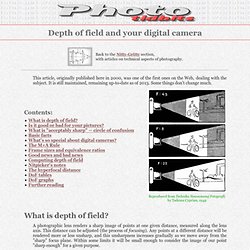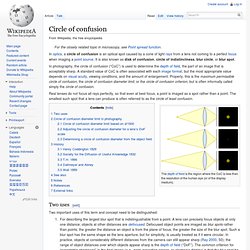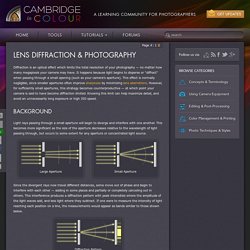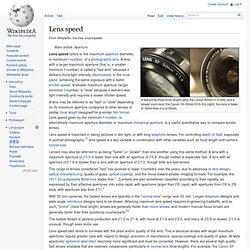

Depth of field and your digital camera. What is depth of field?

A photographic lens renders a sharp image of points at one given distance, measured along the lens axis. This distance can be adjusted (the process of focusing). Any points at a different distance will be rendered more or less unsharp, and this unsharpness increases gradually as we move away from the "sharp" focus plane. Within some limits it will be small enough to consider the image of our point "sharp enough" for a given purpose.
We are talking here only about the unsharpness due to the subject being out of the focused distance. The term depth of field (DOF) is often used to refer to the fact that points not exactly in focus are rendered acceptably sharp in the image. Is it good or bad for your pictures? For many types of photography we would like to have everything in the frame as sharp as possible. Circle of confusion. In photography, the circle of confusion (“CoC”) is used to determine the depth of field, the part of an image that is acceptably sharp.

A standard value of CoC is often associated with each image format, but the most appropriate value depends on visual acuity, viewing conditions, and the amount of enlargement. Properly, this is the maximum permissible circle of confusion, the circle of confusion diameter limit, or the circle of confusion criterion, but is often informally called simply the circle of confusion. DSLR Magnification. By: Nick Rains We live in ‘interesting times’.

Not since colour film was introduced has so much controversy raged about photography. The Internet has allowed vast global discussions to ebb and flow like never before and whilst this is great in some respects, the downside is that there is a whole lot of misinformation floating around. Problem: How to sift the simple facts and truths from the myths and rumours? Lens Genealogy. LENS GENEALOGY Part 1by Roger Cicala Where do new lens designs come from?

I knew that today’s lenses are all designed using computer programs, but I was surprised to find new lenses aren’t designed from scratch. Designers start with an existing lens design and modify it. Of course, a lens designer doesn’t say “this lens really sucks, let’s use it as our starting point”. They start with a good design and try to improve it. So camera lenses, like Darwin’s finches, obey a very strict “survival of the fittest” law. Even knowing this, when I wrote a series of articles on the development of camera lenses, I was amazed to find that virtually every camera lens in use today can trace its heritage back to one of five lenses, four of which were developed by 1900.
Photon. Nomenclature[edit] In 1900, Max Planck was working on black-body radiation and suggested that the energy in electromagnetic waves could only be released in "packets" of energy.

In his 1901 article [4] in Annalen der Physik he called these packets "energy elements". The word quanta (singular quantum) was used even before 1900 to mean particles or amounts of different quantities, including electricity. Later, in 1905, Albert Einstein went further by suggesting that electromagnetic waves could only exist in these discrete wave-packets.[5] He called such a wave-packet the light quantum (German: das Lichtquant).
The name photon derives from the Greek word for light, φῶς (transliterated phôs). Physical properties[edit] Diffraction Limited Photography: Pixel Size, Aperture and Airy Disks. Diffraction is an optical effect which limits the total resolution of your photography — no matter how many megapixels your camera may have.

It happens because light begins to disperse or "diffract" when passing through a small opening (such as your camera's aperture). This effect is normally negligible, since smaller apertures often improve sharpness by minimizing lens aberrations. However, for sufficiently small apertures, this strategy becomes counterproductive — at which point your camera is said to have become diffraction limited. Knowing this limit can help maximize detail, and avoid an unnecessarily long exposure or high ISO speed. Light rays passing through a small aperture will begin to diverge and interfere with one another.
Large Aperture. Sunny 16 rule. The basic rule is, "On a sunny day set aperture to f/16 and shutter speed to the [reciprocal of the] ISO film speed [or ISO setting] for a subject in direct sunlight.

"[1] For example: Lens speed. A fast prime (fixed focal length) lens, the Canon 50mm f/1.4 (left), and a slower zoom lens, the Canon 18–55mm f/3.5–5.6 (right); this lens is faster at 18mm than it is at 55mm.

F-number. Diagram of decreasing apertures, that is, increasing f-numbers, in one-stop increments; each aperture has half the light gathering area of the previous one.

In optics, the f-number (sometimes called focal ratio, f-ratio, f-stop, or relative aperture[1]) of an optical system is the ratio of the lens's focal length to the diameter of the entrance pupil.[2] It is a dimensionless number that is a quantitative measure of lens speed, and an important concept in photography. Notation[edit] The f-number N is given by where is the focal length, and.